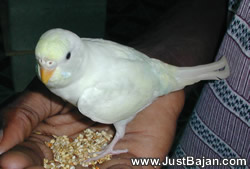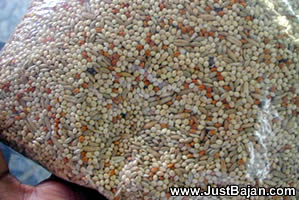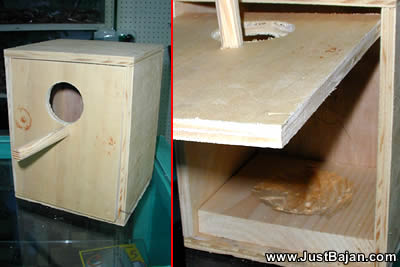| Avg.
Price (BD$): Untrained: $20 each. Trained: $35 - $55 each Availability:
Readily Available Species/genus: Melopsittacus
undulatus Common Name(s): Budgie,
Budgerigar (an Aborigine phrase that means "good to eat"), Parakeet, Keet,
American Parakeet, English Parakeet Adult Size:
6 inches. Life Span: 15 - 20 years

Feeding:
Vegetarian. Make sure your budgie has clean food and water throughout the
day. Change water twice daily, morning and evening. Budgies can be offered a variety
of foods. Special care must be taken to ensure that your budgies get a well balanced
diet, as nutritional deficiencies are a common cause of illness and death. Although
seeds are a budgie's basic diet, if fed only on seeds, they will develop an iodine
deficiency, making them susceptible to goitre (swelling of the thyroid gland). What
can I feed my Budgie?  Budgie
mix (shown on right) can be purchased at the pet shop and is a staple diet containing
a mixture of millet, oat groat and canary seeds. The diet should also include
a daily offering of fruits and vegetables. Who likes to eat the same thing all
the time anyway? Don't be surprise if your budgie doesn't eat the fruits or vegetables
at first. It make take months, but keep trying. Thoroughly clean any fruits and
vegetables you feed to your bird. You can offer your budgies apples, grapes, guava,
mango, orange, pomegranate, watermelon, blanched or grated carrots and green leafy
vegetables such as lettuce and spinach. Budgie
mix (shown on right) can be purchased at the pet shop and is a staple diet containing
a mixture of millet, oat groat and canary seeds. The diet should also include
a daily offering of fruits and vegetables. Who likes to eat the same thing all
the time anyway? Don't be surprise if your budgie doesn't eat the fruits or vegetables
at first. It make take months, but keep trying. Thoroughly clean any fruits and
vegetables you feed to your bird. You can offer your budgies apples, grapes, guava,
mango, orange, pomegranate, watermelon, blanched or grated carrots and green leafy
vegetables such as lettuce and spinach.  However,
do not feed them cabbage, as cabbage will make your budgie sick. Some other foods
to avoid are chocolate, avocado, beans, croton, eggplant, raw peanuts, apple seeds,
raw potatoes and asparagus. It's important for budgies to have calcium in their
diet. Budgie owners provide their bird with calcium by placing a piece of cuttlebone
(the bone of the cuttlefish) in their cages. However,
do not feed them cabbage, as cabbage will make your budgie sick. Some other foods
to avoid are chocolate, avocado, beans, croton, eggplant, raw peanuts, apple seeds,
raw potatoes and asparagus. It's important for budgies to have calcium in their
diet. Budgie owners provide their bird with calcium by placing a piece of cuttlebone
(the bone of the cuttlefish) in their cages.
Note: Budgies shell
the seeds when they eat. Therefore what may look like a container with food might
be a container full of shells (husk). Don't be fooled and let your budgies starve.
This is a common feeding mistake. Also, you should never put new food on top of
old food. Discard the old food and shells first. Keep it clean. A dirty feed container
is a breeding ground for bacteria. Remember to change the drinking water regularly
since food will get into it and your budgie might decide to take a bath in it
as well. Sexual Differences: Easily distinguished
when mature. A budgie's sex is determined by the colour of its cere. The cere
is the fleshy, wax-like membrane at the base of the upper beak surrounding the
nostrils. Adult males have a blue cere and females have a brown cere. A female's
cere will turn a dark brown and might become rough and crusty, when she is in
breeding condition. This is not to be confused with scaly face disease. The
male budgie has a blue cere
 Differentiation
in young budgies is harder to the untrained eye, as the cere in both sexes will
be a purplish colour. The adult colour starts to show after 3 to 4 months of age. Note:
In some budgie colour variations, such as albinos and lutinos, the colour of the
cere can't be used to determine the sex, since in both sexes it is pinkish. However,
female budgies are said to be more aggressive and have a harder bite, or as Bajans
might say, a harder bird pick. Determining
Age: There are 3 areas you can examine to determine the age of your
budgie; the head, eyes and legs:
Head - If your budgies has stripes
(barring) on its head down to its cere, this usually means it under 4 months old.
This is not the case for albinos and lutinos budgies since they don't have stripes.
Eyes - Budgies under 4 months of age usually have completely black eyes.
The exception is yet again for albinos and lutinos whose eyes will always remain
red. After 4 moths of age, budgies usually develop a light gray or white iris.
Legs - If you are lucky, your budgie may come with a band around one
of its legs indicating the year it was born. If you budgie doesn't have strips
on its head or black eyes, this is the only way you will be able to tell how old
it is. Breeding: Difficulty: Very
Easy. Budgies are easy to breed. For obvious reasons, the first thing you
need is a male and female. Now we've gotten that out of the way, the next thing
you need is a nesting box. An external nesting box can be attached to the bird's
cage. The bottom of the box must have a concave bottom for the budgie to lay its
eggs on. Since budgies don't build nest, the concave bottom serves to stop the
eggs from rolling around. Without the proper housing, the budgies may not breed
at all. In the wild, budgies nest in holes in trees. 5 to 6 eggs are laid in a
clutch. Eggs hatch in 18-21 days. Budgies reach sexual maturity in approximately
9 months. Budgie nesting box with
concave bottom
 Cage
Size: The general rule is that bigger is better. Your budgies must
have enough room to fly around for exercise. The length of the cage is more important
than the height. The guideline suggested for minimum cage size is as follows: 20"x12"x18"
for 1 Bird
40"x20"x32" for a Pair The space between the bars is also
quite important. If they are too wide, you can guess what will happen, the bird
will get out. The budgie may also get his head or body stuck if it tries to squeeze
through the bars. To prevent this from happening, make sure that the spaces between
the bars are no wider than ½ inch. Some budgie enthusiasts also recommend that
you get a cage with horizontal bars and to avoid those with only vertical bars.
This is especially so when the cage is small, since the budgie will do more walking
& climbing than flying. The horizontal bars help the budgie to get a better grip
when climbing on the cage. Special Requirements:
Exercise. Budgies need exercise everyday, especially if they live in small
cages. They need to stretch their wings and fly around. Budgies that live in small
cages should be allowed out of the cage for some exercise. Before you let your
budgie out, you must make certain the room is clear of hazards. You probably don't
want your budgie to take an outdoor excursion, he may never come back, so make
sure all doors, windows and other escape routes are closed. Make sure ceiling
fans, or any other fans are turned off (I am sure you don't need an explanation
why). Open flames, mirrors, transparent glass windows or doors, cats and dogs
all can make your budgie a dead bird. You must also be wary of drinking glasses
or any containers with liquid. You certainly don't way your budgie to drink something
poisonous or take swimming lessons. Baths. Unlike some dogs, budgies
like to take baths everyday. Provide a pan of water about 6 to 8 inches in diameter,
with a water depth no deeper than 1 inch. It should not be a swimming pool or
your bird might drown. An unused plant saucer will do fine. Keep the pan clean
because the bird will drink from it as well. The cage will get messy after a bath,
so be prepared to do some cleaning. Sleep: A budgie needs 12 - 14
hours of sleep. Keep the bird in a quiet place away from TVs or radios. If necessary,
cover the cage with a cloth to relax the budgie, and to keep out cold drafts.
Leave the cage partially covered so that the budgie can see out. Make sure the
cloth does not have a strong smell of detergent since it may cause the bird to
have difficulty breathing. Cover the cage around the same time every night so
that your budgie can develop a routine sleeping time. Considerations:
Before you decide to buy a budgie, there are a few things you should consider
first. How many Budgies? - In the wild, budgies live in large groups
and are very social. Therefore they like the company of other birds. It is best
to keep budgies in pairs. However, if you only want one bird, then you have to
become that bird's companion. Give the budgie lots of attention, talk to it and
play with it. The budgie may regard you as its parent and even fly around behind
you. It's also easier to train a single bird, as there are no other feathery companions
to distract it. Noise - Budgies like to sing and sing they do… loudly.
Others call it noise. Will you be able to tolerate the singing or noise? Will
you be bothering your neighbours or other family members? Do you have
Allergies? - Some people are allergic to feathers and the dust budgies give
off. Common Diseases: Scaly face disease
- This is caused by Cnemodocoptes mites. These mites cause scales to appear on
the affected area, usually the face, cere, eyelids and legs, and can cause beak
deformities. Respiratory Disorders - This is usually caused by living
in a dusty environment or by mites. Make sure the bird's cage is cleaned regularly
(every week). Respiratory disorders can be treated with Biomycin Antibiotic, available
in pet stores. Signs of Illness: Sudden changes in behaviour, fluffed
up feathers, difficulty breathing, glassy eyes, poor reaction to stimuli, submissiveness,
drinking more than usual, lost of appetite, weight loss. | 


